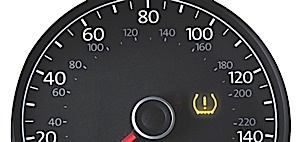
Q: Can the Tire Type and/or Placard Value be changed if aftermarket tires or wheels are installed?
A: The Tire Type (P Metric, LT Load Range C/D/E) and the Placard Value (Front Placard and Rear Placard, individually) are stored in the receiver as calibrations and can be revised on some vehicles through flash reprograming. Since the under-inflation threshold is calculated as a percentage of the placard; correcting the placard values when different tires are installed will bring the vehicle back into compliance.
Q: Can Tire Pressure Monitoring be turned off?
A: No. Tire Pressure Monitoring is now a mandated safety system in the United States and cannot knowingly be disabled by an OEM nor an aftermarket service provider (49 USC 30101).
Q: Will a tire pressure sensor fit in every wheel?
A: Stock wheels are designed to accommodate tire pressure sensors. Many aftermarket wheels also accommodate tire pressure sensors, but not all do. In some, the valve stem hole is placed in such a way (pointing straight into the middle of the wheel on some off-road wheels) that the motion detection components inside the sensor will not work correctly.
Q: Can the sensor be cleaned with a sharp pin?
A: NEVER use a sharp object to clean the pressure port of the sensor; it can be damaged and lead to part failure. If the dirt/grime/obstruction
cannot be removed with a cloth, replace the sensor.
Q: Why are dashes (" – – "), or a pressure value of 148 PSI (1020 kPa), sometimes displayed after a battery disconnect?
A: These displays come up after a battery disconnect/reconnect because the system is waiting for updated pressure information to be sent from the tire pressure sensors. As each sensor transmits its information, the display is updated appropriately. Note that when dashes or 148 PSI (1020 kPa) are displayed after a battery disconnect/reconnect, the System Malfunction warning is NOT displayed because the system is still working properly, and simply waiting for updated information from the sensors. Driving the vehicle above 20 mph (32 km/h) for 2 minutes gets the sensors talking, and restores the correct pressure values to the display. It is also possible to restore the values by using a TPMS tool, using the "Activate" function at each tire to activate the sensor (it is NOT necessary to put the system into Learn mode, in this special case).
Ford Adaptive Cruise Control Alignment Process
Follow these steps for proper horizontal alignment of the cruise control module radar sensor.
• 2010-2017 Taurus, Explorer, Edge, Flex, Fusion, MKS, MKX, MKT, MKZ
• 2015-2017 F150, Mustang, and MKC
• 2017 Super Duty, Escape, and Continental
This is information on setting up and completion steps for proper horizontal alignment of the cruise control module (C-CM) radar sensor.
Chrysler’s Totally Integrated Power Module Simplifies Circuits
The symptoms of a failing TIPM can vary depending on the vehicle. Check out your options for this repair.

Trakmotive Tech Tip: Window Regulator Installation
Here are eight tips to make your next window regulator replacement easier.

Multi-Spark Ignition Systems
You may have seen the stories about plasma or laser ignition systems that promise to give new life to the internal combustion engine. But while these ignition systems have yet to make it to market the latest ignition innovation still uses a coil and spark plug.

VIDEO: How Modules Manage Alternator Power
Andrew Markel discusses power flow through the electrical system on a vehicle, and how the modules help provide the right amount of power to different components. Sponsored by Valeo.

Other Posts
Caring For AGM And Flooded Car Batteries
Faulty battery cables, if loose, corroded, or damaged, can lead to power drainage.

Power Window Regulator and Motor Service
Power windows are great as long as they roll up and down when commanded to do so.

Tesla Model 3 TPMS Service
Resetting and programming TPMS sensors for a Tesla is a lot like any other vehicle, and the challenge is still the same: keeping the light off.

Alternator Testing For No Charge Conditions
Many alternator problems turn out to be nothing more than a bad connection at the alternator or a bad wiring harness.






